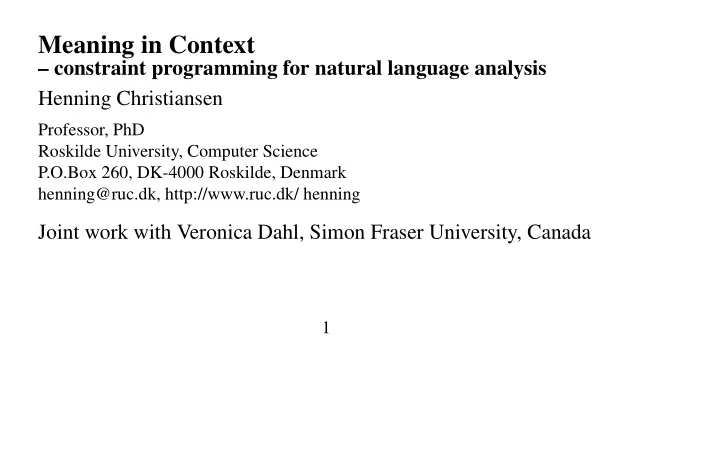

Meaning in Context – constraint programming for natural language analysis Henning Christiansen Professor, PhD Roskilde University, Computer Science P.O.Box 260, DK-4000 Roskilde, Denmark henning@ruc.dk, http://www.ruc.dk/ henning Joint work with Veronica Dahl, Simon Fraser University, Canada 1
Work on constraints in Roskilde • CONTROL project, 2004–2007, funded by Danish SNF “Constraints for Robust Languages processing” HC, John Gallagher, Jørgen Villadsen & assoc. Veronica Dahl, Ph. Blache • Attention to Constraint Handling Rules • CHR Grammars (HC, TPLP 2005). Grammar notation on top of CHR. • Aspects of NLP, extensions to Prolog & CHR, abduction (HC,VD) • Analysis and optimization of CHR (HC, JG) • Looking for practical applications, e.g. deaf peoples’ sign language • CSLP workshop, Roskilde 2004. LNAI 3834; Barcelona 2005? Int’l workshop on Constraint Solving and Language Processing 2
Meaning in Context An illustration of how CLP attitude may bring clarity into NLP. • Simplified notion of meaning that fits better with pragmatics • Basis for co-routining among different layers of analysis • Each sentence interpreted and understood in context, and contributes to context Techological background ... 3
Techological background • CHR, Constraint Handling Rules [Fr¨ uhwirth, 1995, . . . ] – declarative extension to Prolog for writing constraint solvers – available in SICStus Prolog (among others) • A smart way of doing abduction in Logic Programming with CHR – efficient & light-weight – negation limited to so-called explicit negation 4
Constraint Handling Rules, intro. by example :- use_module(library(chr)). handler leq. constraints leq/2. :- op(500, xfx, leq). X leq Y , Y leq Z ==> X leq Z. X leq Y , Y leq X <=> X=Y. X leq Y <=> X=Y | true. X leq Y \ X leq Y <=> true. p(X,Y):- q(X), r(Y,Z), X leq Z. ... Execution model: Constraint store, replace/add constraints Declarative semantics: as indicated by arrow symbols 5
Abduction in Logic Programming Reasoning to find those “missing facts” of a Prolog program necessary to make given query succeed. • Hot topic at logic programming conf. in 90ies • Applications: – planning (event calculus and otherwise) – diagnosis – view updates in databases • Typical implementations by meta-interp., ≈ 20–100 × slower that Prolog An abductive logic program is a Prolog program extended with • A set of distinguished, abducible predicates • A set of integrity constraints to be satisfied by facts invented by interpreter 6
Abduction in Prolog + a little bit of CHR Our trick: • Abducibles → CHR constraints • Integrity constraints → CHR rules • Abductive programs run as Prolog, but with CHR taking care of abducibles Example, view update in a database. .. 7
Abduction in Prolog + a little bit of CHR Example, view update in a database constraints father/2, mother/2, male/1, female/2. parent(X,Y):- father(X,Y) ; mother(X,Y). initial_db:- father(peter,john), male(peter). mother(X,_) ==> female(X). father(X,Z),father(Y,Z) ==> X=Y. ... ?- initial_db, parent(jane,john). ... mother(jane,john), female(jane) ? 8
Analysis of (natural) language as abduction Given discourse assumed faithful to some “real world” Context: (Partial) knowledge about this world Grammar ∧ Context → Sentences Basic assumption: Observe: This works fine with Prolog (DCG) to generate or verify given dis- course known Context. Discourse analysis is an abductive problem. An example... 9
An example, analysis of discourses about still-lifes Integrity constraints about abducible context facts: i_on(X,Y), i_on(Y,X) ==> fail. container(C) ==> thing(C). i_in(the_box,the_vase) ==> fail. i_in(_,C) ==> container(C). ... thing(X) ==> X=the_flower ; X=the_box ; X=the_vase ; X=the_table. container(X) ==> X=the_box ; X=the_vase. container(the_flower) ==> fail. container(the_table) ==> fail. on(X,Y) ==> i_on(X,Y) ; i_on(X,Z), i_on(Z,Y) ; i_in(X,Z), i_on(Z,Y). The grammar: sentence --> [A,is,on,B], {thing(A), thing(B), on(A,B)}. Query: ?- phrase(sentence, [the,flower,is,on,the,table] One of the answers: i_in(the_flower,the_vase), i_on(the_vase,the_table) , ... 10
Meaning-in-context: Taking pragmatics serious He won it The tall, red-haired man carrying a laptop won a brand new Ferrari Both may have the same meaning or purpose to express: won(X,Z) where X and Y are references to objects in (presupposed) context: tall(X), read haired(X), carries(X,Y), laptop(Y), ferrari(Z), brand new(Z) Or to model a passive agent spying a discourse: Sentence meaning: ∅ Sentence presupposes context: tall(X), . . . won(X,Z), As opposed to std. Montague semantics with context-independent λ -terms ... 11
Perspectives • Separating out context greatly simplifies semantic terms • Seems more “pragmatics-oriented” • Allows all levels of analysis interact with context, – resolve lexical ambiguities – identify and employ predefined contexts, gear-box ... brakes ... 200kmh ... ==> predef context(all about cars) • Approach is formalized by possible-worlds semantics [not shown today]; formalization and generalization of R. Stalnaker’s theories about context and accommodation 12
Conclusion • Abduction in Logic Programming can be implemented elegantly and effi- ciently in CHR 2 LP • Works with CHR Grammars [HC, 2001, ..., TPLP 2005] and Prolog in A paradigm [HC,VD, MultiCPL 2004] • Constraint programming (CHR) revives abduction for NL interpretation • ... and gives inspiration to Meaning-in-Context model 13
Recommend
More recommend